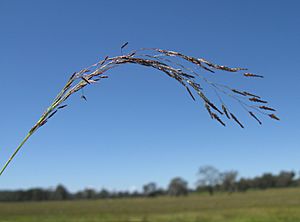Eragrostis pilosa facts for kids
Quick facts for kids Eragrostis pilosa |
|
|---|---|
 |
|
| Scientific classification | |
| Genus: |
Eragrostis
|
| Species: |
pilosa
|
| Synonyms | |
|
Eragrostis multicaulis |
|
Eragrostis pilosa is a type of grass. It's also known by fun names like Indian lovegrass or hairy love grass. This plant grows naturally in places like Europe, Asia, and Africa. It has also spread to many other parts of the world. Sometimes, it can even be seen growing as a common weed.
Contents
What Does This Grass Look Like?
This grass is an annual plant, meaning it grows for one season. It can reach up to 70 centimeters (about 2.3 feet) tall. Its leaves are thin and can be as long as 20 centimeters (about 8 inches).
The stem and leaves often have tiny, sticky pits. These pits can help scientists tell different types of this grass apart. At the base of each leaf, there's a short fringe of hairs called a ligule.
The top part of the plant, where the seeds are, is called an inflorescence. It looks like an open, branched cluster. Each branch can be up to 10 centimeters long. The lowest branches grow in a circle around the stem. The small seed clusters, called spikelets, are narrow and can be grayish or purple-green. They are about a centimeter long and each can hold up to 10 to 17 tiny flowers, called florets.
Where Does This Grass Grow and How Does It Spread?
This grass can grow in many different places. It easily takes root in areas that have been disturbed. You might see it along roadsides or in farm fields. It also likes moist and wet places, including swamps.
The grass spreads its seeds in many ways.
- Seeds can be carried by water and wind.
- They can travel in soil or hay.
- Seeds can also hitch a ride on farm machinery or trains.
It's likely that its seeds can stay alive in the soil for a very long time, forming a "seed bank."
How Is This Grass Used?
Eragrostis pilosa has some useful qualities.
- It can be used as forage for animals to eat.
- It can also be used as fodder, which is dried food for livestock.
- The small grains from this grass can even be eaten by humans!
The Connection to Teff
This grass is very important in farming because it is the main wild ancestor of teff (Eragrostis tef). Teff is a very important staple cereal grain. It is especially important in Ethiopia, where it is a major part of people's diets.
Scientists know these two grasses are closely related because of their genes. They also look very similar, sometimes it's hard to tell them apart! The biggest difference is how their seed heads behave.
- E. pilosa seed heads break apart easily, scattering their seeds. This is called spikelet shattering.
- Teff seed heads do not shatter. This makes teff much easier to harvest as a farm crop.
Even though E. pilosa is related to teff, it's only harvested for grain in Ethiopia when people are really desperate.
Most Eragrostis species are polyploid. This means they have more than two sets of chromosomes. E. pilosa is an allotetraploid. This means it contains genes from different plant species, suggesting it came from a mix of different plants. Teff is also an allotetraploid. Scientists have even been able to create fertile mixes between E. pilosa and teff.
Ecology of the Grass
This grass can sometimes be attacked by a parasitic plant called purple witchweed (Striga hermonthica). This witchweed attaches to the grass and steals its nutrients.

